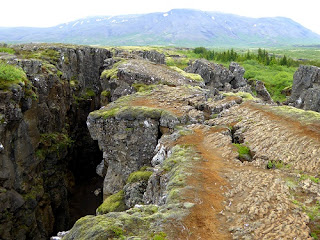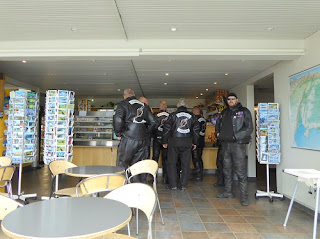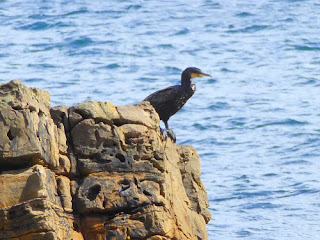Friday, 29 July 2016
Plots against America
That's Charles Lindbergh on the left, the famous aviator who was to lead the America First campaign and decry 'the Jewish race' for trying to lead his country into the Second World War, in the delightful company of Hermann Goering, presumably at the time of the October 1938 dinner in Berlin where Goering presented Lindbergh with the Service Cross of the Golden Eagle. No such photos of Trump with Putin have come to light, prompting some amusingly creative collages which I assume are copyright so won't use here. But you can be sure that if the world's worst-case-scenario comes true and Trump is elected, he'll be holding meetings with Putin like the one Philip Roth imagines a putative President Lindbergh having with Hitler in Iceland, and later with Von Ribbentrop in the White House, in The Plot Against America.
There are probably more differences between Trump and Lindbergh than similarities - no-one sees DT as a clever operator hiding behind others, for instance. But it seemed timely to read this what-if masterpiece of a novel by a great American under present circumstances. Apart from the lethally eloquent and/or direct prose style, Roth's genius is to put himself and his family into the alternative picture, building on the anti-Semitism he experienced in New Jersey as a child.
I can't tell which of the friends and relatives gathered around the Roths are real - would love to read a biography or an alternative study which sheds light on this - but the portraits of his honest ma and pa break the heart. It isn't easy to make ordinary decency that interesting, but put it up against its opposite and you have some powerful situations. If you don't think you want to work your way through the whole book - amazing how people keep on saying 'I don't have the time to read'; there is ALWAYS time to read - then the second chapter. 'Loudmouth Jew (November 1940-June 1941)', about the Roth family visit to Washington and the anti-Semitism they experience there, is a locus classicus of vivid writing. Roth also makes some powerful statements throughout the book about the kind of man his father was, both as an American Jew and as a Mensch. More often he highlights what he was not:
It went without saying that Mr Mawhinney was a Christian, a long-standing member of the great overpowering majority that fought the revolution and founded the nation and conquered the wilderness and subjugated the Indian and enslaved the Negro and emancipated the Negro and segregated the Negro, one of the good, clean, hardworking Christian millions who settled the frontier, tilled the farms, governed the states, sat in Congress, occupied the White House, amassed the wealth, possessed the land, owned the steel mills and the ball clubs and the railroads and the banks, even owned and oversaw the language, one of those unassailable Nordic and Anglo-Saxon Protestants who ran America and would always run it - generals, dignitaries, magnates, tycoons, the men who laid down the law and called the shots and read the riot act when they chose to - while my father, of course, was only a Jew.
Roth (pictured above) makes the distinction between his father and other Jews they knew, though:
For good or bad, the exalted egoism of an Abe Steinheim or an Uncle Monty or a Rabbi Bengelsdorf - conspicuously dynamic Jews, all seemingly propelled by their embattled status as the offspring of greenhorns to play the biggest role that they could commandeer as American men - was not in the makeup of my father, nor was there the slightest longing for supremacy, and so though personal pride was a driving force and his blend of fortitude and combativeness was heavily fueled, like theirs, by the grievances attending his origins as an impoverished kid other kids called a kike, it was enough for him to make something (rather than everything) of himself and to do so without wrecking the lives around him.
As for the Jews who in Roth's dystopia kowtow to Lindbergh (pictured above before the 1941 speech which in reality toppled him), there is a devastating portrait in the shape of Aunt Evelyn who marries the self-satisfied, self-compromised Rabbi Bengelsdorf.
As always with Aunt Evelyn, there was something very winning about her enthusiasm, though in the context of my household's confusion, I couldn't miss what was diabolical about it as well. Never in my life had I so harshly judged any adult - not my parents, not even Alvin or Uncle Monty - nor had I understood until then how the shameless vanity of utter fools can so strongly determine the fate of others.
One can't take it for granted, unfortunately, that more than half of voting Americans come to understand the same thing before it's too late. If they don't, the world will sufer from a regime that might be longer-lived than the fictional presidency of Lindbergh. In the meantime, here's hope
and here may be a greater part of the reason why Donald behaves as he does - behold The Mother.
Wednesday, 27 July 2016
Of Gods and Men again
The only film to watch after the horrific murder of an 86 year old priest, which makes my heart hurt as much as the execution of Palmyra's elderly curator, is one of the few masterpieces of recent years, Des hommes et des dieux. No need to write more about it here than I have already on the blog - invoking that entry for a third time - except to say that it sums up the best thoughts of religion rather than the (many) worst. This very short clip encapsulates connection between people on this earth instead of division. Context: the Catholic priests serving a Muslim community in Algeria, and threatened by terorism, are discussing whether they should leave or not.
Tuesday, 26 July 2016
More black than orange
Any evening at home between Proms and summer jaunts usually includes one episode of Orange is the New Black, Series 4. Netflix's ever-surprising drama about a women's prison is too rich for binge watching. Not only are so many characters and strands involved in each episode, but often their treatment goes so deep that you need time to digest it. So we go one at a time.
Episode 7, which we watched yesterday afternoon, seemed especially layered. Usually there's one 'back story', and this time it belonged to Lolly Whitehill, the mentally unstable character whose past was plumbed so painfully that it raised questions many must ask in America - and actually here too: how can conditions like schizophrenia and paranoia pass undiagnosed, and why should that person end up in prison without proper mental health care? Actor Lorin Petty is carrying a difficult burden here, but she executes it brilliantly, on a high wire between pathos, scariness and humour.
Interestingly the younger Lolly is played (though I'd never have guessed it) by another actress, Christina Brucato (pictured above), and though I haven't looked back to check I presume Petty has taken over by the time we see Lolly on the streets, selling coffee to willing buyers and giving some of it away. You fear something dreadful's going to happen in the prison, but scriptwriter Nick Jones settles for a quiet coda - hope this isn't too much of a spoiler - as Lolly shares a moment inside her 'time machine' with the intermittently touching, flawed inmate counsellor Sam Healey (Michael Harney). Full marks to Jones for giving her so many good and strong lines about the voices in her head.
The terror of the episode belongs to the ongoing story of initial protagonist Piper Chapman (Taylor Schelling) and the upshot of her opportunism in selecting a gang of white racists to be her bodyguard. We love the return of the terrifically sympathetic, big-eyed Nicky (Natasha Lyonne), while our favourite group including Uzo Aduba (Suzanne 'Crazy Eyes' Warren), Adrienne C Moore (Cindy) and Tasha Johnson (Danielle Brooks) are part of a semi-amusing thread involving the exposure of Marth Stewart-alike Judy King (Blair Brown) as the one-time manipulator of a tinted-tainted puppet on TV. Brown is one of the latest additions to a flawless team of actors, any one of whom could garner a special award*. And the main thing is that Orange is the New Black doesn't seem to be falling into the formulaic trap of so many American series, however well they start out. And I always found House of Cards phoney anyway... Now, how the HELL I gonna catch up on RuPaul's Drag Race?
Meanwhile, American 'real' life continues to be as scary as it is comic-grotesque. To learn the extent to which Trump is just one of many Republican fruitcakes, read this brilliant article by Eliot Weinberger in the London Review of Books**. And to plumb the seriousness of Trump's connection to Putin - much of which has yet to come properly to light - this is good (and good on Vilnius, which has every right to feel very scared about Trump's election, for the above; my thanks to Sue Scheid for drawing my attention to the report). Fine coverage, as always, on how it's playing in Russia from The Interpreter. Anything positive to shout about our side of the pond? Only the speechifying of Nicola Sturgeon, the one limelight politician who calls a spade a spade.
* 4/8 Having finished the series, I can say that the last three episodes are well up to the standard of this one. There's a heart-wrenching flashback sequence for Suzanne within a tense lock-down strand and another for the adorable Poussey (Samira Wiley).
**Postscript - and this LRB article, which I've only just discovered, is the best long read on Brexit of any I've come across.
Friday, 22 July 2016
Birds and their haunts: Suffolk, Iceland, Fife
No twitcher I, though it's easy to see the attraction now I'm using the rather good zoom on my Lumix for closeups, subsequently looking up the birds I didn't know and/or consulting an expert. On the first of the days in question, sunshine followed downpours at Snape and lone birds were waddling along the Alde at low tide, including this Little Egret (Egretta garzetta).
A Redwing (Turdus iliacus) shattered the silence on the lava field in the north of Iceland's Þingvellir National Park, seen on a day excursion between the concerts of brilliant Víkingur Ólafsson's Reykjavík Midsummer Music,
and a lone heron graced the rocks as I walked the stretch of the Fife coastal path between Anstruther and Crail, from one East Neuk Festival venue (the simple church in the village of Kilrenny) to another.
The Snape marshes with the Alde winding through them I saw in two very different lights, the clear afternoon of my first, flying visit
and - the Icelandic trip having briefly intervened - a dawn with proper sunrise, c.3.30am, at the start of the Aldeburgh Festival's unforgettable, unrepeatable Bird Day with Pierre-Laurent Aimard choosing avian calls and scenes from Messiaen's Catalogue d'Oiseaux to suit four different times in the nearly-24-hour progress.
Let's give the Little Egret a little more context, both wider-angle and closer up,
and look at the other loner on that first afternoon, a mud-pecking Oystercatcher (Haematopus ostralegus).
Cumulo-nimbus clouds of the kind which had cause a big storm in Ipswich earlier in the afternoon were still visible on the horizon,
seen here through Barbara Hepworth's Family of Man
with a circle of clear blue sky and marsh as bonus.
Somewhat more prehistoric at 3.30ish am:
The dawn chorus of the Sunday morning was not overloud, but there were various warbles from among the reeds, and I was puzzled to hear stridulation at that time in the morning. All was explained in the late night talk given by ornithologist Nigel Collar and Messiaenist Chris Dingle - I had been hearing the Grasshopper Warbler (Locustella naevia). A wonderful film showing the undistinguished and secretive little bird's non-stop 'song' sealed the discovery. Remained unseen somewhere among the reeds here.
It had been a day of little action at one of the hides in the RSPB's Minsmere sanctuary by the time we turned up there in the late afternoon.
I'd been hoping to hear the low boom of the Bittern, reproduced so magically by Messiaen, but sightings had stopped many hours earlier and one twitcher suggested that the wind wasn't helping matters.
More impressive were the flowers - orchids and irises like these, always beautiful to see
and the set-up on Whin Hill
where we carried a picnic to the site
and Aimard managed to accomplish his third clump of pieces before the first spots of rain.
One of the pleasures at Minsmere was to chat to Roger Wright on the walkway to the bird hide. He was as quick-thinkingly amusing as ever when I told him of my bird-sightings in Iceland, responding with something, more wittily phrased than I can remember, about the genuses divided into -dottir and -son.
Nature is everywhere, even in never too urban Reykjavik. My hotel was part of the control-tower complex at the (now domestic) airport beyond the bus station, and the short stroll into town and back was accompanied by the shrieks of defensive Redshanks (Tringa totanus) sitting on the airport's perimeter fence and occasionally practically divebombing the walker.
They didn't seem to resent a couple of Jack Snipes sharing the territory.
Down in the harbour a female Eider duck (Somateria mollissima) was bobbing in the midnight sun with two chicks.
More waterbirds were to be found on the Öxará river which flows into the lake of Þingvallavatn. The river bisects the ground where Iceland's parliament, the Alþingi, was founded in 930 AD. The territory also happens to be the astonishing area where the North American and Eurasian tectonic plates are tearing apart, creating more than one rift valley.
Here's a White Wagtail (Motacilla alba) on a moss-covered rock
holding what looks like a bee in its mouth on the cliff as we wended our way downwards from the Visitor Centre (Samantha Holderness and I took a bus from Reykjavik which was going on to the other wonders of the Golden Triangle and got off at Þingvellir so that we could spend most of the day walking there. We ended up getting a lift back to town with the lovely students working in the cafe where we ended up).
Can't work out if this is a Grebe or a Merganser
floating on the Öxará near the church.
Uphill a bit, the chick of a Grey Lag Goose (Anser anser) got detached from its mother
and eventually rejoined her.
The waters were most evocative in a still tributary
and at Öxarárfoss, the waterfall higher up in the main rift
where the green of a camomile-like grass made a bright contrast to the rock. This patch seems to have a crater in it.
This stretch of rift valley led us upwards through a path where hangings used to take place under Danish rule - the Icelanders preferred not to implement capital punishment - rather than through the wood as planned, which meant rejoining the one road through the area. But to one side of that was a special stretch of rift
which seemed to have recently opened-up clefts on the lava mounds with their interesting patterns above it.
Another river, the Grimagilsklækur, flowed on the higher ground, rich in waterside flora,
and we took the road route down to the National Park Centre for lunch with other fauna (the jovial bikers were a small part of Iceland at leisure on its National Day).
Having established that the friendly girl behind the counter would drive us back to Reykjavik, I found I had enough time to follow the only path over the neighbouring lava field, Sleðaàshraun. This was the quietest and in many ways the strangest route of all, familiar to me from wading around the Berserkjahraun on the Snæfelsnes peninsula. The moss grows thick on boulders and in crevasses
while on the trees which punctuate this otherwise moonlike landscape
sat the Redwings, calling to each other (or warning each other, or me, off).
Landscape and birdsighting on my four-mile Fife coastal path walk may have been less other to my perception, but the skies between showers and storm cast a clear and beautiful light over sea and land.
The noisy bird on a shrub this time I reckon must be either a Marsh or a Willow Tit (difficult to differentiate).
Eiders were bobbing in convoy close to the shore, just as I'd seen them on another stretch two years earlier
while the heron remained solitary, as usual,
and a lone cormorant perched on the edge of another rockline.
All this was worth lingering over, but by the time I reached some deserted huts with Crail just over the hill, black clouds had begun to mass inland and at around this point I heard a massive clap of thunder.
For all the speed with which I hoofed it into Crail, I didn't escape a hailstorm and, one minute away from the cottage where I was staying, got drenched to the skin. Looked forward to a nice cup of tea once I'd been picked up with no time to change and driven to Cambo House, only to find that the cafe had been closed due to flooding. The rest of the day remained unsettled, but Sunday morning dawned clear and bright, and I end not with birds - I heard some but saw none this time - but with rocks on the Crail beach, some substitute for not finding a suitable spot to swim there (I got my obligatory annual Fife bathe later in the day).
I leave you with a taste of things to come, courtesy of top Estonian photographer Kaupo Kikkas. This wonderful colony, the Estonian Festival Orchestra which gathers ever year with Paavo Järvi (in the centre below) in the summer capital of Pärnu, would fly if they could. They certainly gave us wings in their two magnificent concerts.
I can hardly wait to write about another remarkable time with the best of orchestral players - and indeed all else that the Pärnu Festival has to offer. This is one event in the calendar that I hope never to miss so long as the enterprise continues to flourish.There will be a full report on The Arts Desk on Sunday week, and more here eventually, but in the meantime here's my eulogy to the 2015 experience.
Subscribe to:
Posts (Atom)





































































